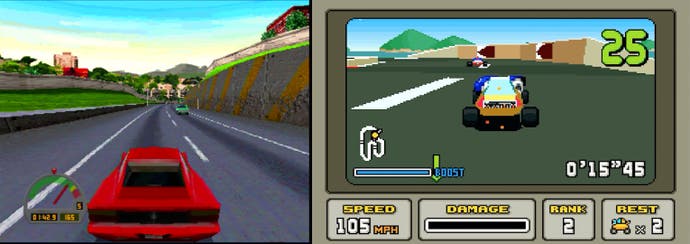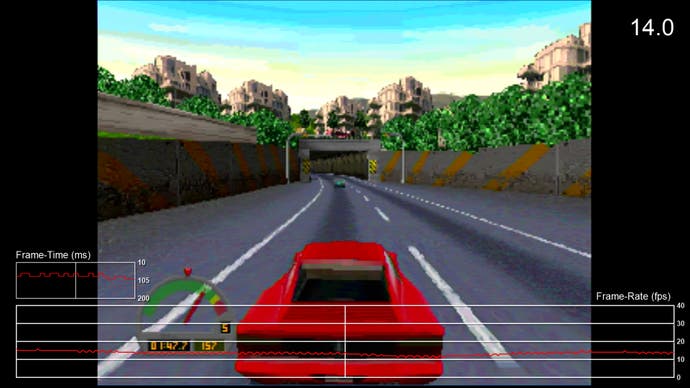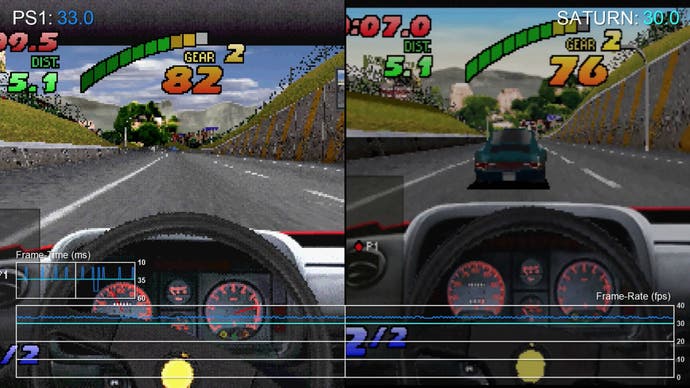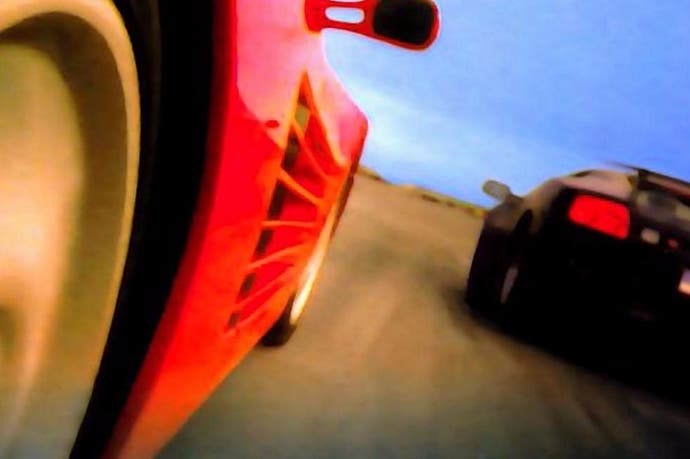DF Retro: Revisiting the original Need for Speed
How a state-of-the-art 90s racer kickstarted a franchise phenomenon.
In the world of racing games, there are few franchises that have stood the test of time as well as Need for Speed. With over 150m copies sold across multiple gaming generations, the intoxicating blend of iconic sports cars and arcade-style driving remains as appealing as ever, but what are the origins of the series itself? We went back to the original 1994 franchise debut - Road and Track Presents the Need for Speed - a cutting-edge game initially released on a failing console, quickly gaining traction across multiple ports and releases, making the most of the mainstream technology of the era: PC, PlayStation and Saturn. In this article, we'll be looking at all of them and offering suggestions on the best way to play the game today.
Of course, these days, the world of realistic console driving games is dominated by the likes of Gran Turismo and Forza - games that celebrate the automobile, powered by phenomenal simulation models and bestowed with beautiful, super-realistic visuals. However, if you flash back to 1994, the racing genre was a very different place. Arcade racers by Sega ruled the roost, while those searching for a more realistic take on driving were serviced exclusively on PC by the likes of Papyrus Design Group with its superb IndyCar and NASCAR simulations. Console gamers really didn't have a lot of choice.
During this same period, the 3DO Interactive Multiplayer was just one year into its short life, boasting cutting-edge 3D graphics that were well suited to the racing genre. But the 3DO itself was a series of specifications defined by the 3DO company as opposed to a singular fixed platform. Licensees used these specifications to build bespoke boxes and Panasonic was the first to market with its FZ-1 model. Without the cushion of software royalties to fall back on, the company decided to launch at $700, making it the most expensive console on the market - yes, even more than the Neo Geo. The console lasted just three years, due in part to its price, but during its short life, the system received some impressive software - and The Need for Speed attracted plenty of attention.
At its core, the game was designed to capture the sensation of sitting behind the wheel of a high-end sports car, driving at speed through environments presented via then-revolutionary 3D graphics. The Need for Speed was developed by Electronic Arts Canada but its lineage can be traced back to a different name - Distinctive Software Incorporated, creators of the precursor to the original Need for Speed: Test Drive. This series first appeared in 1987 with its sequel, The Duel: Test Drive 2, hitting two years later. In 1991, the studio was acquired by Electronic Arts, where it became known as EA Canada. Three years after the acquisition, The Need for Speed was released and an iconic franchise was born.
As was becoming increasingly common at the time, The Need for Speed featured fully 3D environments and polygonal cars. The visuals are boxy by today's standards but at the time, it was an incredible sight to behold - a huge leap beyond the likes of Stunt Race FX, released on Super NES in the same year. The mountainous curves on Alpine can be seen twisting into the distance while the Coast offers up stunning beaches and steep overhangs - it was remarkably evocative for a racing game. Of course, there are many tricks happening beneath the surface - distant objects, for instance, are often represented via two-dimensional bitmaps rather than as 3D objects but the illusion was still effective.
The game featured three views - an interior cockpit view and two external options, with gameplay focused on a duel with a single other AI racer - cheesy 90s cliche, the 'X Man'. The cockpit view is presented with close facsimiles of original vehicle interiors and even a set of working gauges. Like the Test Drive games that preceded it, the transmission shifter also appeared on-screen dynamically every time you switched gears. In fact, when you first get behind the wheel, there isn't even a countdown - the game waits for you to shift into first gear before the race begins. It sets a precedent for a different kind of driving experience - despite its name, The Need for Speed was a slower-paced game. It's neither an arcade racer nor a simulation and in many ways, feels more like a precursor to Gran Turismo as a result.

Now, as enjoyable as its races are considering the technology of the era, there is one significant flaw that holds back the game when played in retrospect - the frame-rate. The 3DO could never quite keep up with the action and The Need for Speed runs below 20fps with an average frame-rate hovering around 15fps. It feels incredibly sluggish by today's standards but when you stop and consider the competition, it feels more acceptable. Rival consoles were left with far less detailed racing games generally running at even slower frame-rates. Even on PC, most systems from this era were incapable of matching the prowess of the 3DO.
If you're looking to replay this specific version today, there is some good news - an emulator by the name of 3DO Play, based on the older Freedo emulator, is available and can play The Need for Speed at a smoother frame-rate with improved image quality. By overclocking the virtual CPU to 30MHz from 12.5MHz, throughput is increased to a near constant 30 frames per second. However, other ports exist with much better performance and an improved set of in-game features.
A PC version appeared in August 1995, with a refined interface and new content. One of the most important changes is the introduction of actual races against a full pack of cars as opposed to the one-on-one action of the original. Even a full-on tournament mode has been added into the mix making for a well-rounded package. One you get behind the wheel, it quickly becomes apparent that the core game has been modified as well. The cars drive at a much faster rate on PC - the hills on Alpine could now send your car launching into the air, while which is impossible on 3DO. The new, faster pace was a lot of fun and made for a game that felt more like an arcade racer as opposed to a driving game. In that sense, the PC version is basically an entirely new game.

Visually, the MS DOS conversion seems to be the game on which other ports would be based. Many of the textures were modified and some of the visual features of the original were eliminated. You can opt between 320x200 and 640x480 resolutions with the latter reserved for faster Pentium class PCs of that era. While the visuals were sharper, the PC version was also limited to an 8-bit 256 colour palette, resulting in obvious banding - 3DO games were generally rendered using 24-bit color or a 16-bit palletised mode in comparison, giving a smoother look. Other elements were removed, such as the shifting horizon, which adjusts based on the camera position on 3DO. For many fans of the series, this is where the franchise truly got its start, but alas the crazy 90s stylings of the 'X Man' were cruelly omitted.
1996 saw the release of Saturn and PlayStation versions, again sporting a new interface, and three time of day selections for every track. Beyond that, the same faster pace of the PC conversion remains in effect - this is a very quick game indeed. It's not just the way the cars drive either, the frame-rate sees a massive increase on both consoles. The Sega Saturn turns in a relatively stable 30 frames per second throughout the game while PlayStation runs with a completely uncapped frame-rate leading to an average somewhere around 33fps. Both feel much smoother than the 3DO original and also retain its higher colour depth - though the PlayStation version exhibits noticeable dithering throughout its image.
While the Saturn and PlayStation conversions were very similar, there are several differences to point out here. For one thing, when using the cockpit view, Sega's console is lacking working instruments - a feature that is present in every other version of the game. The two-dimensional background graphics also vary between them - PlayStation features a wider range of backgrounds and restores the scaling feature from 3DO. We also noticed subtle graphical touches on Sony's machine including a faked lighting effect applied to the car as you drive through a tunnel, perhaps inspired by Namco's Ridge Racer.

Another noticeable difference lies in the audio - the PlayStation version offers players the chance to enjoy music while racing (something not possible on any other version). With a great blend of rock and electronic music, the pounding soundtrack helps bring the game to life in a big way. The tracks were composed by multiple people including the late Saki Kaskas, who worked on a huge number of EA games, and Jeff van Dyck - the talented musician that would eventually work on games such as the incredible Alien Isolation and Assault Android Cactus.
Ultimately, these two mainstream console versions were well made, offering players a great entry point to a series previously restricted to more expensive gaming hardware. A wealth of content was on hand, the performance was smooth and the handling was great. It was a fast, semi-arcade style racing game that is still very playable today - though clearly a product of its era. However, these were not the only new iterations of the game released in 1996. A new Special Edition arrived on PC, featuring support for both MS DOS and Windows 95, along with additional content, including two new tracks, and the full PlayStation soundtrack. It was even possible to play the game online with friends. This was the most refined iteration of the game yet and remains an excellent way to revisit The Need for Speed.
From relatively humble beginnings on a failed console, Need for Speed quickly evolved into something of a franchise juggernaut - a series that has thrived on reinvention across its 23-year history, from the original Hot Pursuit, through to the iconic Underground reboot and the release of Most Wanted alongside Xbox 360. The series reached new heights under the stewardship of Criterion Games with its own Hot Pursuit and Most Wanted reboots, but there's perhaps the sense that the franchise lost its way a little in 2015's Need for Speed.
However, even with 22 series entries released over the years, the core appeal of Need for Speed can't be denied - driving the world's most powerful supercars to their limits and beyond was an irresistible proposition back in 1994, and Forza Horizon 3's recent, phenomenal success demonstrates that the right game can still provide a fresh, thrilling experience based on the same basic template. Can current NFS developer Ghost Games match or surpass the Playground Games classic? We should hopefully find out later this year...


